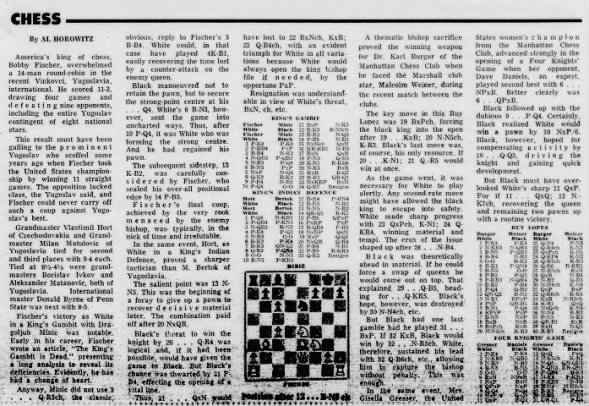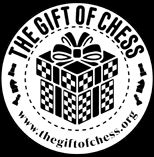The Province Vancouver, British Columbia, Canada Friday, January 03, 1969 - Page 47
Chess
America's king of chess, Bobby Fischer, overwhelmed a 14-man round-robin in the recent Vinkovci, Yugoslavia, international. He scored 11-2. drawing four games and defeating nine opponents, including the entire Yugoslav contingent of eight national stars.
This result must have been galling to the prominent Yugoslav who scoffed some years ago when Fischer took the United States championship by winning 11 straight games. The opposition lacked class, the Yugoslav said, and Fischer could never carry off such a coup against Yugoslav's best.
Grandmaster Vlastimil Hort of Czechoslovakia and Grandmaster Milan Matulovic of Yugoslavia tied for second and third places with 9-4 each. Tied at 8½-4½, were grandmasters Borislav Ivkov and Aleksander Matanovic, both of Yugoslavia. International master Donald Byrne of Penn State was next with 8-5.
Fischer's victory as White in a King's Gambit with Dragoljub Minic was notable. Early in his career, Fischer wrote an article, “The King's Gambit is Dead,” presenting a long analysis to reveal its deficiencies. Evidently, be has had a change of heart.
Anyway, Minic did not use 3…Q-R5ch, the classic, obvious reply to Fischer's 3 B-B4. White could, in that case have played 4K-B1, easily recovering the time lost by a counter-attack on the enemy queen.
Black manoeuvred not to retain the pawn, but to secure the strong-point centre at his…Q4. White's 6 B-N3, however, sent the game into uncharted ways. Thus, after 10 P-Q4, it was White who was forming the strong centre. And he had regained his pawn.
The subsequent sidestep, 13 K-B2, was carefully considered by Fischer, who sealed his over-all positional edge by 14 P-B5.
Fischer's final coup, achieved by the very rook menaced by the enemy bishop, was typically, in the nick of time and irrefutable.
In the same event, Hort, as White in a King's Indian Defence, proved a sharper tactician than M. Bertok of Yugoslavia.
The salient point was 13 N-N5. This was the beginning of a foray to give up a pawn to recover decisive material later. The combination paid off after 20 NxQR.
Black's threat to win the knight by 20…Q-R4 was logical and, if it had been possible, would have given the game to Black. But Black's chance was thwarted by 21 P-B4, effecting the opening of a vital line.
Thus, 21…QxN would have lost to 22 BxNch, KxB: 23 Q-B4ch, with an evident triumph for White in all variations because White would always open the king bishop file if needed, by the opportune PxP.
Resignation was understandable in view of White's threat, BxN, ch. etc.
A thematic bishop sacrifice proved the winning weapon for Dr. Karl Burger of the Manhattan Chess Club when he faced the Marshall club star. Malcolm Weiner, during the recent match between the clubs.
The key move in this Ruy Lopez was 19 BxPch, forcing the black king into the open after 19…KxB; 20 N-N5ch K-R3. Black's last move was of course, his only resource. If 20…K-N1; 21 Q-R5 would win at once.
As the game went, it was necessary for White to play alertly. Any second-rate move might have allowed the black king to escape into safety. White made sharp progress with 23 QxPch. K-Nl; 24 Q-KR4, winning material and tempi. The crux of the issue shaped up after 28…N-B4.
Black was theoretically ahead in material. If he could force a swap of queens he would come out on top. That explained 29…Q-B5, heading for…Q-KR5. Black's hope, however, was destroyed by 30 N-N4ch, etc.
But Black had one last gamble had he played 31…BxP. If 32 KxB, Black would win by 32…N-R5ch. White, therefore, sustained his lead with 32 Q-B6ch, etc., allowing him to capture the bishop without penalty. This was enough.
In the same event, Mrs. Giselle Grosser, the United States women's champion from the Manhattan Chess Club, advanced strongly in the opening of a Four Knights' Game when her opponent. Dave Daniels, an expert, played second best with 6…NPxB. Better clearly was 6…QPxB.
Black followed up with the dubious 9…P-Q4. Certainly, Black realized White would win a pawn by 10 NxP/6. Black, however, hoped for compensating activity by 10…Q-Q3, driving the knight and gaining quick development.
But Black must have overlooked White's sharp 11 QxP. For if 11…QxQ; 12 N.-K7ch, recovering the queen and remaining two pawns up with a routine victory.
 Chess by Al Horowitz 03 Jan 1969, Fri The Province (Vancouver, British Columbia, Canada) Newspapers.com
Chess by Al Horowitz 03 Jan 1969, Fri The Province (Vancouver, British Columbia, Canada) Newspapers.com






















